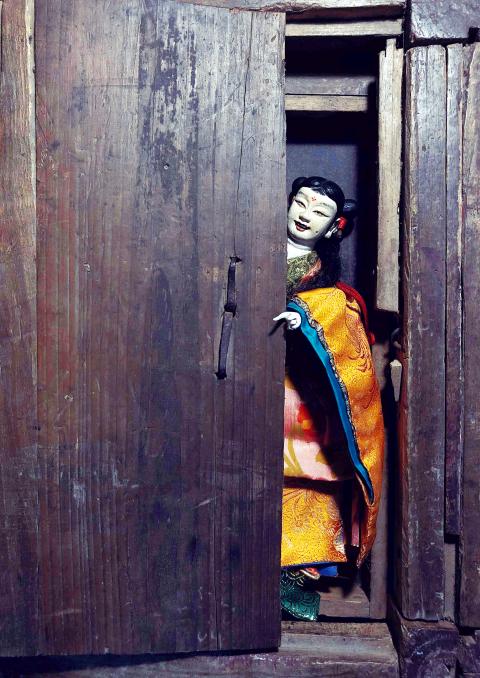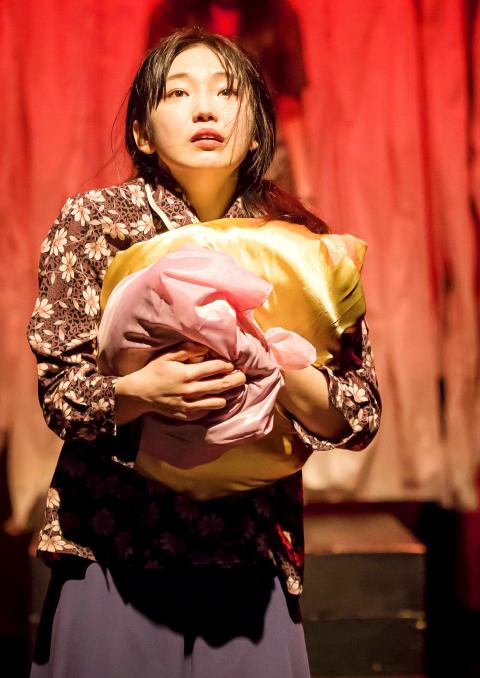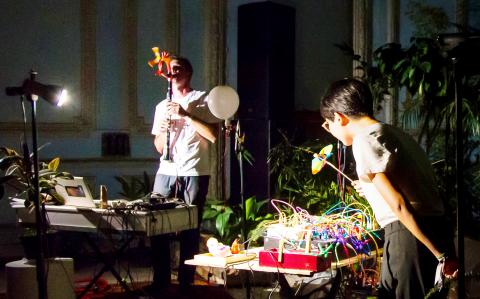“F” on alphabet blocks often stands for fall. In Taipei and many other places around the country, “F” for fall has increasingly meant festival with a capital “F” as well.
The National Theater has its Dancing in Autumn series, the National Taichung Theater has its Fall for Great Souls, in Taipei’s Guandu District (關渡) there is the month-long Kuandu Arts Festival (關渡藝術節邁) and in Keelung, the theme of the Keelung Ciao (基隆潮藝術) festival, which opened on Sept. 27 and runs through Nov. 8, is “Find Your Flow.”
The latest to join the ranks are the fifth annual Tua-Tiu-Tiann International Festival of Arts (TTTIFA, 大稻埕國際藝術節) in one of Taipei’s oldest areas, which began last week and runs through the end of the month.

Photo courtesy of Unique Puppet Theater
There is also the eight annual Tainan Arts Festival (臺南藝術節), which opens today and runs through Nov. 10.
Tua-Tiu-Tiann is the old name for the Dadaocheng (大稻埕) area — Taipei’s original arts district. The festival, which aims to explore the area’s cultural, historical and international connections, is funded by local businesses and arts groups.
In addition to the usual line up of theater, dance and music performances and lectures by Taiwanese and foreign artists — more than 40 in all — the festival includes street exhibitions and programs designed to connect Dadaocheng’s past with its present.

Photo courtesy of 26 Theatre
The international contingent hails from Thailand, Vietnam, Japan, South Korea, Hong Kong and Austria, some of whom have artist residencies and will be giving workshops as well as performing.
The Vienna-based sound-artist duo Siedl/Cao will perform Super Token (超級象徵) tomorrow and Rediscover the Forgotten ‘Treasures’ through Sound (透過聲音,再次發掘遺忘的「珍寶」) from Saturday next week through Nov. 9.
Vietnamese Cao Thanh Lan and Austrian Gregor Siedl work in the field of contemporary electronic and instrumental music, music theatre and sound art. They were one of five groups to receive the New Austrian Sound of Music 2018-2019 award for contemporary music.

Photo courtesy of Siedl/Cao
The South Korean troupe 26 Theatre will perform Flower Road (花路), a story about Korean comfort woman in China at the end of World War II who are worried about returning home and what kind of reception they will receive from their family and hometowns. It will be performed on Oct. 25 and 26.
The Unique Puppet Theater (不貳偶劇), a collaboration between puppeteer Kuo Chien-fu (郭建甫), Japanese storyteller Ryo Kanagawa and musician Lin Jun-rou (林均柔) will perform Persist (道成) on Friday and Saturday next week.
The always popular 1920 Dress Up Parade will be held on Dihua Street on Oct. 20
More information about TTTIFA programs and artists is available on the festival’s Web site, in Chinese and English (www.tttifa.com).
TAINAN ARTS FESTIVAL
The Tainan Arts Festival also seeks to link Taiwan’s first capital’s past and present through cultural performances and exhibitions indoors at its three cultural centers, teahouses and library, as well as outdoors at historic sites such as the Eternal Golden Castle and parks.
This year’s theme is “The Invisible City” and there will be six theater, four dance and six music productions as well as five “site-specific” productions, grouped under the categories of “Urban Legend,” “Urban Investigation,” “Made in Taiwan,” “Theater Limited” and “Music.”
While some of the shows are ticketed, many events are free.
One example of a free “Urban Investigation” event is a collaboration between Taiwanese freelance choreographer/dancer Chou Shu-yi (周書毅) and the Tainan-based Scarecrow Contemporary Dance Company (稻草人舞團), Body Map in the Tainan Park -100 Days Strolling (臺南公園的身體地圖一百日行走), which will be performed at 4pm on Friday, Saturday and Sunday next week.
A ticketed “Urban Legend” event, Puppets Meet Ceremic Art on Yuguang Island (土土海海漁光島), is a collaboration between potter Wu Chi-chen (吳其錚) and actor/director Hsueh Mei-hua (薛美華) and runs from Friday to Sunday next week.
More information on the programs and artists is available at tnaf.tnc.gov.tw/2019.

Wooden houses wedged between concrete, crumbling brick facades with roofs gaping to the sky, and tiled art deco buildings down narrow alleyways: Taichung Central District’s (中區) aging architecture reveals both the allure and reality of the old downtown. From Indigenous settlement to capital under Qing Dynasty rule through to Japanese colonization, Taichung’s Central District holds a long and layered history. The bygone beauty of its streets once earned it the nickname “Little Kyoto.” Since the late eighties, however, the shifting of economic and government centers westward signaled a gradual decline in the area’s evolving fortunes. With the regeneration of the once

Even by the standards of Ukraine’s International Legion, which comprises volunteers from over 55 countries, Han has an unusual backstory. Born in Taichung, he grew up in Costa Rica — then one of Taiwan’s diplomatic allies — where a relative worked for the embassy. After attending an American international high school in San Jose, Costa Rica’s capital, Han — who prefers to use only his given name for OPSEC (operations security) reasons — moved to the US in his teens. He attended Penn State University before returning to Taiwan to work in the semiconductor industry in Kaohsiung, where he

On May 2, Chinese Nationalist Party (KMT) Chairman Eric Chu (朱立倫), at a meeting in support of Taipei city councilors at party headquarters, compared President William Lai (賴清德) to Hitler. Chu claimed that unlike any other democracy worldwide in history, no other leader was rooting out opposing parties like Lai and the Democratic Progressive Party (DPP). That his statements are wildly inaccurate was not the point. It was a rallying cry, not a history lesson. This was intentional to provoke the international diplomatic community into a response, which was promptly provided. Both the German and Israeli offices issued statements on Facebook

Perched on Thailand’s border with Myanmar, Arunothai is a dusty crossroads town, a nowheresville that could be the setting of some Southeast Asian spaghetti Western. Its main street is the final, dead-end section of the two-lane highway from Chiang Mai, Thailand’s second largest city 120kms south, and the heart of the kingdom’s mountainous north. At the town boundary, a Chinese-style arch capped with dragons also bears Thai script declaring fealty to Bangkok’s royal family: “Long live the King!” Further on, Chinese lanterns line the main street, and on the hillsides, courtyard homes sit among warrens of narrow, winding alleyways and